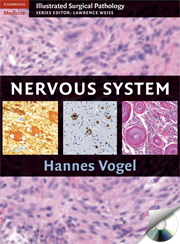Book contents
- Frontmatter
- Contents
- Contributors
- Preface
- Acknowledgments
- 1 Normal Anatomy and Histology of the CNS
- 2 Intraoperative Consultation
- 3 Brain Tumors
- Brain Tumors – An Overview
- Brain Tumor Locations with Respect to Age
- Grading Brain Tumors
- NEUROEPITHELIAL
- TUMORS OF CRANIAL AND PARASPINAL NERVES
- TUMORS OF THE MENINGES
- LYMPHOMAS AND HEMATOPOIETIC NEOPLASMS
- GERM CELL TUMORS
- NONNEOPLASTIC MASSES AND CYSTS
- PATHOLOGY OF THE SELLAR REGION
- METASTATIC NEOPLASMS OF THE CENTRAL NERVOUS SYSTEM
- SKULL AND PARASPINAL NEOPLASMS, NONNEOPLASTIC MASSES, AND MALFORMATIONS
- CNS-RELATED SOFT TISSUE TUMORS
- 4 Vascular and Hemorrhagic Lesions
- 5 Infections of the CNS
- 6 Inflammatory Diseases
- 7 Surgical Neuropathology of Epilepsy
- 8 Cytopathology of Cerebrospinal Fluid
- Index
SKULL AND PARASPINAL NEOPLASMS, NONNEOPLASTIC MASSES, AND MALFORMATIONS
from 3 - Brain Tumors
Published online by Cambridge University Press: 04 August 2010
- Frontmatter
- Contents
- Contributors
- Preface
- Acknowledgments
- 1 Normal Anatomy and Histology of the CNS
- 2 Intraoperative Consultation
- 3 Brain Tumors
- Brain Tumors – An Overview
- Brain Tumor Locations with Respect to Age
- Grading Brain Tumors
- NEUROEPITHELIAL
- TUMORS OF CRANIAL AND PARASPINAL NERVES
- TUMORS OF THE MENINGES
- LYMPHOMAS AND HEMATOPOIETIC NEOPLASMS
- GERM CELL TUMORS
- NONNEOPLASTIC MASSES AND CYSTS
- PATHOLOGY OF THE SELLAR REGION
- METASTATIC NEOPLASMS OF THE CENTRAL NERVOUS SYSTEM
- SKULL AND PARASPINAL NEOPLASMS, NONNEOPLASTIC MASSES, AND MALFORMATIONS
- CNS-RELATED SOFT TISSUE TUMORS
- 4 Vascular and Hemorrhagic Lesions
- 5 Infections of the CNS
- 6 Inflammatory Diseases
- 7 Surgical Neuropathology of Epilepsy
- 8 Cytopathology of Cerebrospinal Fluid
- Index
Summary
A surprising number of cases come to the attention of the surgical neuropathologist that represent extraneural masses originating in the bone or other soft tissues, simply because these are within the spectrum of practice in neurosurgery. These represent a wide gamut of etiologies including primary and metastatic neoplasms, infections, malformations, and others. Just as in the proper evaluation of any CNS lesion, knowledge of the radiographic features and overall clinical circumstances is of paramount importance in making a correct diagnosis. Many of the entities listed below may be seen in association with either the skull or spinal column even though they all have distinct sites of predilection.
Among the following, the most common benign entities to involve the skull are fibrous dysplasia, Langerhans cell histiocytosis, osteoma, dermoid cysts, and hemangiomas.
Neoplasms of the skull and skull base may be best conceptualized as arising in one of the following compartments:
Pituitary region (Chapter 3G)
Nasal and paranasal sinus region, including olfactory neuroblastoma, olfactory neuroepithelioma, neuroendocrine carcinoma, nasopharyngeal carcinoma, juvenile angiofibroma, and mucocele
Orbital region, including meningioma, lymphoma, rhabdomyosarcoma, and malignant melanoma
Middle ear compartment, including paraganglioma, cholesteatoma, squamous cell carcinoma, and endolymphatic sac tumor
Skull base tumors, including chondroma, chondrosarcoma, chordoma, meningioma, and schwannoma
- Type
- Chapter
- Information
- Nervous System , pp. 318 - 337Publisher: Cambridge University PressPrint publication year: 2009

